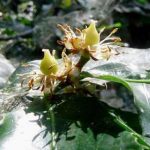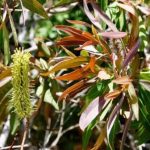TREE LIFE
March 1984
MASHONALAND CALENDAR
Tuesday March 6th : Botanic Garden Walk. Meet in the car Park at 1645 for 1700 hours. Usually we are lucky enough to have Tom Muller, the Director of the Gardens and Herbarium to lead us around exploring a theme; say a plant family or an ecological grouping. Tom’s infinite knowledge makes it a very worthwhile hour, or so.
Sunday March 18th : A visit to John Jones’ home at Twentydales beyond Epworth combined with the AGM. As mentioned last month John is a keen ornithologist especially in the recording field and keen to preserve the birds’ habitat. It is only 20km from town and not worth taking a bus, so no bus has been arranged. Instead, we appeal to members to meet at the Monomatapa Car Park at 0900 hours to share transport especially for the benefit of those without transport i.e. we are keen to have as many members as possible present. We will, as usual arrange for a Security Guard to look after the cars left there. We will then meet at the Farm at about 0930 hours. We will then do some treeing in the morning and dispose of the AGM at 1200 hours before lunch. In the afternoon we will do some more treeing. This is a super venue. I hardly believed there could be such a fantastic variety of trees so close to Harare.
MATABELELAND CALENDAR
Sunday March 4th : Meet at 0830 hours at the aloes at Hillside Dams. Last Sunday’s outing to the Burnside end of the ‘vlei’ included talks by three members on Commiphoras and the BURSERACEAE, Mimusops and the SAPOTACEAE and Turraea nilotica and the MELIACEAE. More of this in the next issue.
BOTANIC GARDEN WALK, 7TH FEBRUARY 1984
I must take the responsibility for not contacting Mr. Tom Muller before the Botanic Garden walk. Mr Bob Drummond who was present informed us of the latest developments within the APOCYNACEAE. We looked at the toad tree of the Vumba. This species of Tabernaemontana produced heavy fruit resembling large medicine balls which fall from the forest canopy with an alarming thuds. This species as now reverted to its old name T. stapfiana so the T. angolensis applies to the Zambian species. We wandered over to see the very large rubbery leaves on the Zambian specimen, which also has subtle differences in its floral structure.
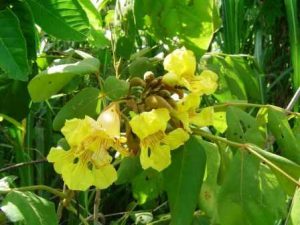
Markhamia obtusifolia . Photo: Bart Wursten. Source: Flora of Zimbabwe
Alongside the T. angolensis we noted the yellow flowers on the lowveld Markhamia obtusifolia so we then examined most of the other members of the indigenous BIGNONIACEAE. This family has excited me for a long while. Somehow the fact that all frogs should have a three chambered heart never surprises me as much as the idea of finding a trumpet like BIGNONIACEAE flower and opening it to reveal four well developed stamens and one withered staminode. BIGNONIACEAE often have showy flowers and are very much part of our country’s colour. The enormous orange flowers on the exotic African Spathodea brighten up Zimbabwe’s avenues while the Brazilian Jacaranda carpet the roads with mauve flowers that explode beneath the car wheels. The pink flowering Zimbabwe creeper, Podranea brycei is a common garden ornamental that also belongs to this family.
The typical BIGNONIACEAE leaf is opposite, imparipinnately compound with few (less than six) pairs of large, often slightly furry leaflets. The Jacaranda is an exception. Markhamia obtusifolia has typical leaves although the upper surface becomes glabrous with age. The yellow flowers have reddish streaks in contrast to the other species, M. acuminata where the maroon is aggregated into flecks. This later species also has fewer leaflets, 3 pairs as opposed to 5, and is fairly frequently encountered on our outings with the Chegutu branch.
Also alongside the herbarium we saw Fernandoa magnifica which was unfortunately not in flower. This tree from the eastern border has large orange, crimson and yellow flowers that exude so much nectar it trickles down the floral tube collecting as a glistening drop along the lip. This irresistible fluid is as sweet as honey while the petals have the smooth texture of satin beneath the tongue. This must surely be an unhealthy occupation so we don’t know who does it – although it sure beats the indigenous confectionary.
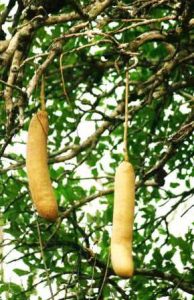
Kigelia africana. Photo: Bart Wursten. Source: Flora of Zimbabwe
We also noted a sausage hanging from the sausage tree, Kigelia africana. This species has deep maroon flowers with a wrinkled texture and hand in pendulous sprays. The flower is replaced by an ever expanding sausage shaped fruit, a hard and heavy item that fully justifies the local fears of sleeping beneath it.
Jacaranda flowers are an excellent classroom teaching aid as the floral pigment is an anthocyanin compound. This means that it is related to litmus, as in litmus paper, and so turns red in an acid, like vinegar, but remains blue in an alkali. The idea is the same as in the Hydrangea although Jacaranda flowers need to be soaked in the acid to see the colour change. As yet I have not tried to turn the indigenous pink jacaranda, Stereospermum kunthianum flowers blue in an alkali but am very keen to try. Stereospermum are conspicuous along the Kariba road when they are in flower. Closer to home there is also a single tree outside the front door of Speciss College in Rhodes Avenue.
We did not look at the at three tree species in the BIGNONIACEAE as they can be seen on the far side of the garden in the South East Lowveld section The two species of Rhigozum were discussed in November when one was seen in full flower.
Catophractes alexandri we often pass on our walks in the botanic gardens where one specimen is labeled BIGNONIACEAE and another PEDALIACEAE, apparently this species has undergone shuffling between these two very closely related families. I would like to thank Bob for helping us out at such short notice.
-Kim ST.J.Damstra
OUTING TO BOISSERAIN FARM, WEDZA NORTH, 19TH FEBRUARY 1984
For quite a number of years the Harare Branch has cheated the elements. However this month they tasted sweet revenge and our host Richard Moore grinned broadly! For two weeks no rain had fallen, instead the Elements waited patiently until we were far from shelter with only open trailers and a slow tractor for transport before pouring out the much needed water. It was a bedraggled group of drowned rats that finally arrived back at the homestead to be warmed up with hot tea and a blazing log fire, thanks to Mrs. Moore, Audrey and Richard.
It was a long trip to Wedza and because the bus could not negotiate a narrow bridge, Richard had organized a slow but enjoyable tractor train to the house. En route we admired some stately Brachystegia boehmii specimens. This was followed by a most welcome cup of tea. It was therefore quite late before we actually started looking at trees near the house.
On the perimeter of an anthill we came upon Cassine aethiopica with its roundish leaves and typically serrated leaf margin. I always find this difficult to identify and it’s really one of those trees which one just has to become familiar with. So it is with Dovyalis zeyheri and it is perhaps not surprising then that we failed at first to notice the latter growing intertwined with the former until keener eyes observed the glossier and more diamond shaped appearance of the Dovyalis leaf, a common FLACOURTIACEAE feature. On the same anthill C. transvaalensis was also found. This has a rather similar serrated leaf but it is narrower and more elongated. We were then able to compare the small leaves of a mature Dombeya rotundifolia with the relatively large round leaves of a knee high juvenile specimen nearly. It is a common trend in many trees to find large leaves on juveniles and in coppice growth whereas the adult tree has small leaves. Your Chairman then put his foot in it by calling a large Acacia riemanniana, Albizia amara. With fine leaves on both trees this was understandable but the failure to observe thorns, making it definitely Acacia was unforgivable. Actually close inspection shows the very much finer, more minute leaflets of Acacia rehmanniana. Next to this, for easy comparison, was A. karroo, with larger leaflets and yellow flowers as opposed to white.
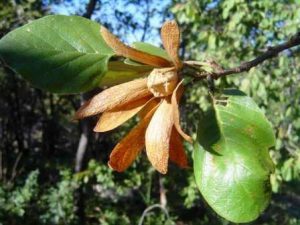
Monotes engleri. Photo: Bart Wursten. Source: Flora of Zimbabwe
In this area we saw three trees which typically have a pale underside to the leaves. First, we ‘live long’ Lannea discolor, with a compound imparipinnate leaf. Second, the asymmetrically shaped leaf of Grewia monticola, donkey berry, and third Monotes engleri, which has the so called “extrafloral nectar” at the base of the leaf on the midrib. We also saw this on M. glaber, which however, does not have the bi-coloured leaf.
Newer members were introduced to the diagnostic feature of Cassia singueana when it is without flowers or pods. This is the little “bee sting” between each pair of leaflets. Close by were some old specimens of Faurea saligna of the protea family PROTEACEAE. It was from the timber of these that Richard Moore had made the exceptionally fine sideboard and dining table which we admired in the house. A munondo Julbernardia globiflora, caused some interest. Well, not the tree itself, but the infestation of tiny red parasitic flowers on the branchlets. When I say flowers, I mean that, for the plant consists almost entirely of the flower. Being a parasite there is no need for leaves. This is supposed to be one of the smallest of all flowering plants. Brian Best told us that it was a Pilostyles, possibly P. aethiopica.
Two members of the EBENACEAE, ebony family, were seen. First a scrambling Diospyros lycioides or star apple and later a substantial Euclea divinorum on a termitarium.
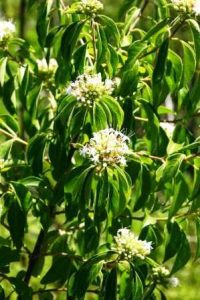
Clerodendron glabrum. Photo: Bart Wursten. Source: Flora of Zimbabwe
Once again this month we were able to compare the pink petioled Maytenus senegalensis with M. heterophylla, a common member of anthill communities. Also standing cheek by fowl on an anthill were Clerodendrum glabrum and C. myricoides, the latter having a more velvety and more serrated edged leaf than C. glabrum. The leaves of the C. glabrum grow in whorls of 3, whereas in C. myricoides they are opposite or alternate. Yet another comparison was made possible between Rhus lancea and Rhus tenuinervis. All our Rhus species are trifoliate, and the leaves have a characteristic smell when crushed, these were no exception. However, with these two the similarities ended there. Rhus lancea has smooth dark green and very slender, narrow pointed leaves with entire margins. R. tenuinervis on the other hand has velvety hairs on the leaflets which are much rounder, pale green and serrately margined.
During this short walk we were also able to look at Combretum molle with its soft velvety leaves and the four winged fruit as well as C. apiculatum which has pointed, twisted tips to the leaves. Also of interest to our newer members were the black dots on the leaves of Pavetta schumanniana containing bacteria which, according to the latest theory, stimulate the plant’s growth hormones.
After lunch on the lawn we again climbed onto the trailers and after passing drought stricken maize and fields of partly reaped burley tobacco we jumped off to walk down a track alongside a stream. On the banks above were some old musasas, Brachystegia spiciformis. Even more impressive were a couple of enormous Schotia brachypetala of great girth and height. Richard has used a piece of timber from one of these trees for his mantelpiece. While still fresh it is a sort of pale green but oxidizes in time to very dark brown The wood is heavy and hard and soon wears down the blades on power tools.
Also on this bank was a Combretum collinum which this time showed the pale underside of the leaf. Alongside the stream was C. erythrophyllum, the river combretum, which demonstrated the typically leaning trunks sending up vertical branches. Later, C. hereroense was also seen, five Combretum in one day.
I put my foot in it again by suggesting that an Ochna pulchra was a Hexalobus, but one look at the flaking bark was sufficient to prove me wrong. Overhanging the stream was a scrambling specimen of the shiny leafed Rhamnus prinoides complete with rather insipid tasting red berries.
Before the heavens finally opened to soak us we had a chance to look at Burkea africana, Peltophorum africanum, Psorospermum febrifugum, the African holly and Securinega virosa, the snowberry.
Our thanks go to the Moores for drying us and warming us up and to Audrey for tolerating all those muddy feet in the house. Special thanks go to Graham Kilpert for ferrying several loads of us back to the bus, and Eileen McBean for providing entertainment in the kitchen.
J.P.Haxen
ROOT NOTES : An observation on Cussonias in the Matabeleland notes in the latest Newsletter reminds me of an occasion about a year ago when, in the Mazowe area, we saw what appeared to some of us to be C. arborea and C. natalensis growing close together. We began to have doubts when, a little later, we found palmate leaves and digitate leaves on the same plant. Moreover, the relatively large number of lobes on the palmate leaves was suspect, C. natalensis normally has only 5, I gather, and infrequently only 3. Mr. Drummond, when we produced specimens to him, unhesitatingly identified them all as C. arborea, a less unassuming man would have made the point – to which my attention was drawn later by Brian Best – that in Drummond’s “Common Trees of the Central Watershed Woodlands of Zimbabwe” (p.174), the leaves of C. arborea are described as “usually digitate, but may be palmate in young plants or on sucker shoots”.
-Dick Petheram
ROOT NOTE : The write up on the botanic garden walk in October, when we looked at the APOCYNACEAE, states “Alongside the Funtumia is Voacanga schweinfurthii which Tom still expects to find in Zimbabwe as it does occur less than a mile into Mozambique”. Well, since then Tom has found it in the Haroni-Rusitu valley so it can now stand proudly in the low altitude rain forest section of the National Botanic Gardens. Well done Tom.
An even more recent note than the above comes from Brian Best who has heard that V. schweinfurthii is now V. africana and our old friend Iboza, the ginger bush, is now Tetradenia.
-Kim ST.J.Damstra
ROOT NOTE : The early part of this century was wrought with scientific arguments on the possible source of sleeping sickness in man and cattle. It was discovered that the latex of a member of the EUPHORBIACEAE, Euphorbia tirucalli, the rubber hedge, had microscopic flagellate animals swimming inside it. These appeared identical to the beast responsible for trypanosomiasis or sleeping sickness. It was postulated that these were transmitted to man by the tsetse fly, Glossina pallidipes after it had fed on members of the EUPHORBIACEAE. This vegetable diet idea was rejected in the 1930’s when extensive experiments failed to encourage the tsetse to suck plant latex and if force-fed they died before they could have bitten anyone. The vegetable diet of tsetse fly was not really such a ridiculous idea as the proboscis appears suitable for sucking nectar and some male mosquitoes suck both blood and nectar. The little trypanosomatis beast, now called Phytomonas, is now known to occur in the latex of a number of EUPHORBIACEAE and is transmitted by a plant sucking bug, Pachybrachius bilobata scutellatus. The latex is rich in dumb bell shaped starch grains on which they feed. It would be interesting to see how many of our local EUPHORBIACEAE are inhabited by similar parasites.
-Kim ST.J. Damsra
LEARNER GROUP
Jill Masterson will be doing a Learners’ Clinic on Saturday morning, 10th March. Further details phone Jill in advance – 303435.
-PHIL HAXEN, CHAIRMAN


